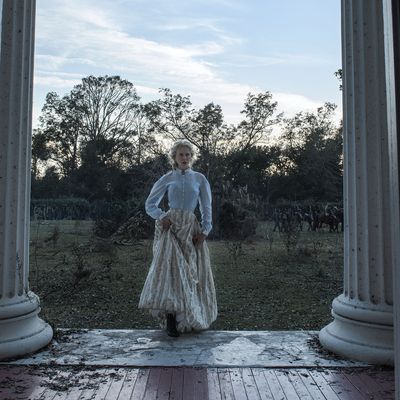
One of the most exciting things about more female-directed major movies is the prospect of women going back to stories that have already been told by men and reframing them, subjecting them to the “female gaze.” Sofia Coppola has done that — probingly, powerfully — with her remake of Don Siegel’s 1971 The Beguiled.
The narrative — adapted from a novel by Thomas Cullinan — is largely identical in both films. During the Civil War, a wounded Union corporal (Clint Eastwood in Siegel’s movie, Colin Farrell in Coppola’s) is taken in and has his injuries treated at a southern girls’ boarding school, where staff and the small group of students debate whether to turn him over to the Confederate Army (which might well lead to his death), let him slip away, or keep him around for all sorts of manual labors.
The presence of a handsome male disrupts the routine and then some. Women and girls dress more carefully and sneak into the soldier’s bedroom to flirt. The corporal, meanwhile, senses a means of gaining power and manipulates each woman in turn. His objective is survival, but he wouldn’t mind something more, well, tactile, too. What happens next is a nightmare, like The Bacchae filtered through the sensibility of a Catholic schoolboy (which Cullinan was). Although Cullinan tells the story through shifting, first-person female points of view, he’s sensitive to the sexual tension in women who are taught to rise above their desires. The heart of his book is a primal male dread, which Siegel’s The Beguiled magnifies.
Coppola comes from the opposite direction, in which the primal threat is to women. She gives The Beguiled a soft but radiant palette, her frames suggesting a fragile equilibrium between unruly nature and gentility. The antebellum manor (with its straight, proud columns) is soiled from lack of care, the gardens are overgrown, and the boom of distant cannons breaks the peace, but the school remains a refuge, a beacon of civilization in an ugly (male) world. It’s Farrell’s Corporal McBurney who introduces dirt, blood, flesh — and earthy desire. The washing of his body and wounds is both a holy rite and deeply erotic. And even hobbled, he feels his power.
Farrell might not be the masculine icon that Eastwood was, but his McBurney is more cunning and more sexually invasive. (Opposite women, Eastwood was rather cool.) Coppola and her editor, Sarah Flack, are alert to his effect on the women, the way signals pass among them, consciously or not, the way they find themselves vying for attention and measuring themselves against one another. Elle Fanning’s Alicia is one of the first to urge Miss Martha (Nicole Kidman) to turn McBurney over to the rebels at once, but she’s also the first to steal into his room to plant a kiss on his lips. Although McBurney is magnetized by her, it’s the prim, older Edwina (Kirsten Dunst) who flushes the most easily and seems, to him, the easiest to control.
It should be said that Siegel didn’t let McBurney off the hook. He went out of his way — rupturing the movie’s syntax with tiny flashbacks — to show that the corporal is a liar and an opportunist. The difference between the two visions comes down to Miss Martha. Played in 1971 by Geraldine Page, she quivers with longing and seethes with resentment, and when McBurney is wounded again in the course of a tryst with one of the girls, a demonic glint comes into her eye. The surgery she performs is a symbolic castration. To Siegel, this poor schmuck never had a chance.
Kidman is as different from the Method-trained Page as an actress can be, and their Marthas are a world apart. When Farrell’s McBurney cries out that Martha mutilated him because he wouldn’t come to her bed, the accusation has no weight. Yes, this Martha has longings, but she’s rigorously proper. Coppola has changed the school from a poisonous cauldron stirred by a madwoman into something worth saving. Without violating Cullinan’s scenario, she has liberated her women from the charge of being succubi.
Why does this matter? Because misogyny has often been justified on mythical, even religious grounds, and stories like The Beguiled feed the idea that men are helpless before women’s demonic wrath. Coppola’s The Beguiled doesn’t have the southern-gothic kick of its predecessor. It’s not a horror movie. Its power is in its undercurrents, in the sense that what we’re seeing isn’t inevitable but a sort of worst-case scenario of genders in opposition. No one is wholly good or bad. Both sides are beguiled.
*This article appears in the June 12, 2017, issue of New York Magazine.


